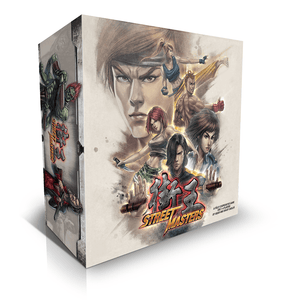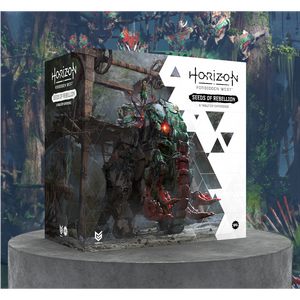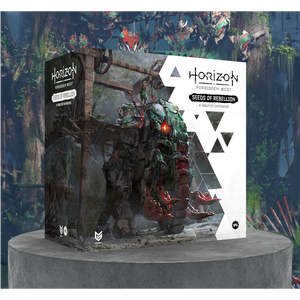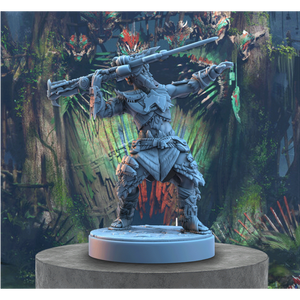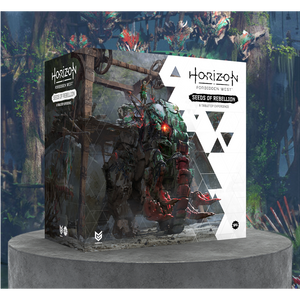Welcome back, Marshals!
Horizon Forbidden West: Seeds of Rebellion is coming to Kickstarter on November 21. In these designer diaries, I (Fraser McFetridge) am sharing a behind-the-scenes look at how we’re translating the Horizon Forbidden West video game to your tabletop.
If you missed the last diary on Forbidden West machines, you can find it here.
Now you’ve got a glimpse of just how dangerous those machines can be, let’s take a look at what new tools your Marshals have to tackle the challenges ahead.

New here? Here’s a quick background — Horizon Forbidden West: Seeds of Rebellion is a new, standalone board game that uses the same engine as Horizon Zero Dawn: The Board Game with some key differences. Unlike Zero Dawn, Seeds of Rebellion is fully cooperative and story-driven, so we’ve made some changes to the player and machine mechanics to work with that new experience.
Stay Stealthy
There’s a lot to get into here, so let’s start with one of the bigger features.
Once we decided to make Seeds of Rebellion fully cooperative, we knew we’d need to take a serious look at one element in particular: stealth and alerting enemies.
A core part of Horizon’s gameplay DNA is the stealthy process of preparing the field of combat before an all-out melee. Aloy crouches in tall grass, lays traps and triple-notches elemental arrows, then fires off as many shots as possible before her target is alerted to her presence.
We knew how important it would be to translate this core experience to the tabletop, and spent many (many, many) hours testing possible iterations. Ultimately, here’s where we landed:

In Seeds of Rebellion, each Marshal has their own threat token, and the enemies share an alert token. When your Marshal acts, their token moves up the track. Some actions, like attacking, move the enemies’ alert token down. Guess what happens when those tokens meet?
The responsible Marshal’s token moves to the threat track, they’re revealed, and the enemies (ALL the enemies!) stop their docile patrol and go on the offensive.
It’s a simple system that offers you a breadth of gameplay options. Could your actions leading up to an encounter buy you more time? What secondary objectives can you achieve, staying hidden while the Marshals who’ve been revealed distract your enemies?
Will you build your action deck, equip weapons and armour for a stealthy approach, or run into combat bellowing a warcry? Destroy a machine’s deadly weapon before they can use it against you? Litter patrol routes with incapacitating blasts?

Oh, and speaking of, traps are something else we’ve redefined for Seeds of Rebellion.
Setting Traps
Once we’d made the gameplay co-op and updated the stealth mechanics, we had the perfect opportunity to revisit how traps work in the board game.
Now, every Marshal has a trap card as part of their standard equipment. Like weapons and armour, traps can be upgraded or swapped as your campaign progresses (more on that later).

Cleverly-placed traps can be the difference between life and death in the Forbidden West. Simply put, enemies set them off when they move onto them.
Easy. But… maybe not that easy. Because those traps don’t just hurt enemies. They hurt everything around them! So, take care to lure your enemies, but don’t get yourself, or your fellow Marshals, caught in the blast.
And we didn’t just update traps. We designed a whole suite of new abilities around them. Which Marshal among you will learn to hide, misdirect, and dominate the battlefield from the shadows, as an expert trapper?

And there’s more…
Yes, Marshals can place their own traps. But the Forbidden West is as deadly as it is majestic, which means the environment itself can prove the deadliest trap of all.
We’ve designed a variety of unique environmental traps for our new, story-driven combat encounters. They might take some effort to set off, but the payoff will be worth it!
(A little pro tip for you: The set-up might be something to work on while you’re still hidden…)
Growing Your Character: Component Hunting and Deck Building
Last but not least, how will your Marshals actually develop and make progress in the board game?
I’m sure this won’t be a massive surprise, but we had a LOT of fun designing all new weapons, armour and abilities for new tribes and clans. I’ll get into specifics on those in another upcoming blog.
For now, let’s look at how character progression works overall.

As you’d imagine, changing from the hunting quest format of Horizon Zero Dawn: The Board Game to a narrative campaign has some big implications for character progression.
First off, the campaign is longer. Quite a bit longer. That left us with two options: More spaced-out progression, or more stuff to progress with.
We chose more stuff. Which led to too much stuff for me to cover in detail here, but we can talk broad strokes.
To start with, if you’ve played the video game, you’ve probably hunted for specific components to upgrade your gear. Now, we’re bringing that to the tabletop!
In Horizon Forbidden West: Seeds of Rebellion, not only is there an entire arsenal of different weapons and armour not featured in the Horizon Zero Dawn board game (to go hand-in-hand with the new machines and rebel salvage), but each can be upgraded through unique, in-game objectives.
Not only that, but when you meet new NPC’s, complete quests, and explore different territories of the Forbidden West, you’ll collect new action cards, giving you the freedom to build your decks as you see fit.
In fact, we’ve designed a slew of new action cards to give you a ton of options when it comes to building your deck.
Will you become a stealthy melee assassin? A master of the elements? An unparalleled trapper? A deadly archer? A resilient defender? A potent tactician? Or something totally new?
What’s Next?
We’ll be back next week with a different kind of update. In the meantime:
- To get notified when the Kickstarter launches and be one of the first to pledge, hit Notify me
- To get emails when there’s an update, subscribe to our newsletter
- To hang out with us and talk Seeds of Rebellion, join our Discord

 Join us on Discord
Join us on Discord


